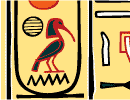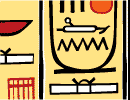Keys to this period
1) Rulers did not last long!!!
2) Hyksos invade from Asia - eventually expelled by a Theban family (Ahmose)
3) Chariot, composite bow, and bronze weapons first introduced.
Summary
During this period of instability which lasted two centuries, rule was short, the Hyksos invaded from Asia and was eventually brought to an end by a Theban family, one of whom (Ahmose) finally expelled them, and new weapons were now discovered due to the invasion of the Hyksos.
The rulers of the 13th Dynasty some 50 or more in about 120 years were weaker than their predecessors, although they were still able to control Nubia and the administration of the central government. During the latter part of their rule, however, their power was challenged not only by the rival 14th Dynasty, which won control over the delta, but also by the Hyksos, who invaded from western Asia. By the 13th Dynasty there was a large Hyksos population in northern Egypt. As the central government entered a period of decline, their presence made possible an influx of people from coastal Phoenicia and Palestine and the establishment of a Hyksos dynasty. This marks the beginning of the Second Intermediate period, a time of turmoil and disunity that lasted for some 214 years. The Hyksos of the 15th Dynasty ruled from their capital at Avaris in the eastern delta, maintaining control over the middle and northern parts of the country. At the same time, the 16th Dynasty also existed in the delta and Middle Egypt, but it may have been subservient to the Hyksos. More independence was exerted in the south by a third contemporaneous power, the Theban 17th Dynasty, which ruled over the territory between Elephantine and Abydos.
The Theban ruler Kamose, who reigned about 1576-1570 B.C., battled the Hyksos successfully, but it was his brother, Ahmose I, who finally subdued them, reuniting Egypt.
|
|
|





